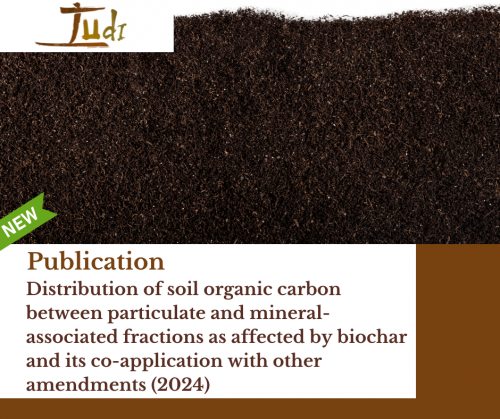TUdi article: Distribution of soil organic carbon between particulate and mineral-associated fractions as affected by biochar and its co-application with other amendments
The article “Distribution of soil organic carbon between particulate and mineral-associated fractions as affected by biochar and its co-application with other amendments” was published in the “Agriculture, Ecosystems & Environment” journal, and is available in the TUdi library.
Biochar, a charcoal-like material produced by burning organic matter derived from agricultural and forestry waste, is used in soil management to store carbon and enhance soil fertility. However, the long-term impact of biochar application on the protection of soil organic carbon from microbial decomposition remains uncertain.
The article presents a study which took place throughout a 9-year-long term field experiment and investigated the protection of organic carbon (C) by minerals and iron (Fe) in biochar-amended soils or soils combined with either municipal solid waste compost or sewage sludge. The particulate organic matter (not protected by minerals) and mineral-associated organic matter fractions were isolated and measured, and the mechanisms of Fe-mediated protection were then analysed using Fe K-edge extended X-ray absorption fine structure spectroscopy. Compared to soil that was not treated with any amendments, soils that were amended with biochar - particularly when it was combined with municipal solid waste compost and sewage sludge - had three times the amount of particulate organic carbon. When combining biochar with municipal solid waste compost and sewage sludge it resulted in a 1.5 times increase in the mineral-associated carbon content in the soil, meaning that biochar helped to bind more organic carbon to soil minerals.
However, the increase in mineral-associated organic carbon was not as large as the increase in particulate organic carbon. The levels of Fe(III)-organic matter complexes in both the particulate and mineral-associated organic matter fractions of the amended soils were similar to those of the unamended soils. The main Fe oxide phase in both the particulate organic matter fraction of all the soils as well as in the mineral-associated matter fraction of the unamended soils was represented by Hematite, whilst in the mineral-associated organic matter fraction of the amended soils ferrihydrite was more abundant.
The potential of biochar, alone or in combination with other amendments, is highlighted as a strategy to store and preserve carbon in soils.
